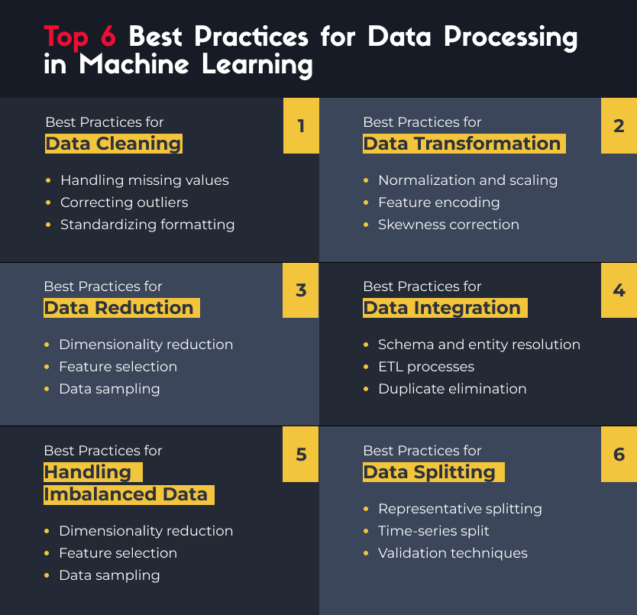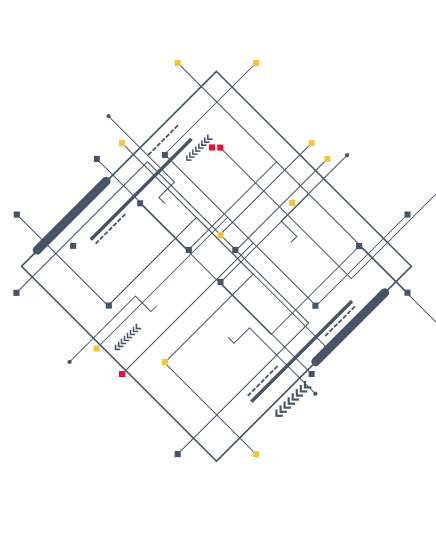In the realm of machine learning, data preprocessing in machine learning is paramount. This crucial step involves transforming raw data into a clean and usable format. Effective machine learning data preprocessing ensures that the data fed into models is accurate, consistent, and relevant, significantly impacting their performance and accuracy. This article will explore the most important steps of data preprocessing.
What is Data Preprocessing in Machine Learning?
Data preprocessing in machine learning is a critical phase that transforms raw data into a format suitable for analysis. It involves several data preprocessing steps in machine learning, such as data cleaning, normalization, and feature selection. These steps are essential to ensure data quality and relevance. Effective machine learning data preprocessing enhances the performance of models, enabling more robust data analytics solutions and better decision-making.
Why is Machine Learning Data Preprocessing Important?
Machine learning data preprocessing is vital because it transforms raw data into a clean, usable format, ensuring high-quality input for models. This process involves handling missing values, normalizing data, and encoding variables, which are essential data preprocessing steps in machine learning. By refining the data, organizations can achieve more accurate predictions and reliable insights, ultimately enhancing their data analytics solutions and decision-making capabilities.

The future of data preprocessing in Machine Learning
The future of data preprocessing for machine learning is increasingly focused on automation and intelligence. As data volumes grow, efficient machine learning data preprocessing will become essential for model performance. Automation tools will streamline tasks like data cleaning, normalization, and feature selection, reducing manual effort and errors.
Additionally, advanced techniques will integrate AI to handle complex data issues, such as missing values and outliers. The rise of diverse data sources, including unstructured data, will further drive innovation in preprocessing methods. Organizations prioritizing effective data preprocessing for machine learning will unlock deeper insights and enhance decision-making capabilities, ensuring they remain competitive in a data-driven landscape.
Steps in Data Preprocessing
1. Data Collection
Sources of data:
Relational databases and data warehouses are common sources, where structured data is stored in tables and can be queried using SQL. Data warehouses integrate data from multiple sources and are optimized for query and analysis. APIs and web services are also valuable sources of data. Public APIs provide access to data from various services and platforms, such as the Twitter API for social media data or the Google Maps API for geographical data.
Web scraping is another method of data collection, involving the extraction of data from websites using tools and libraries like BeautifulSoup and Scrapy. This method is useful for gathering data from web pages that do not provide APIs, though it is important to respect the website’s terms of service and legal considerations.
Surveys and questionnaires are commonly used in market research, social sciences, and customer feedback collection. Logs and event data, generated by systems and applications, provide valuable insights for monitoring system performance, analyzing user behavior, and detecting anomalies.
Public datasets, made available by governments, research institutions, and organizations, are another valuable source of data. Examples include the UCI Machine Learning Repository, Kaggle Datasets, and government open data portals. Social media platforms also provide a wealth of data, such as posts, comments, likes, and shares, which are often used for sentiment analysis and trend detection. Finally, internal company data, such as sales records, customer information, and operational data, is often used for business intelligence, customer relationship management, and operational optimization.
Types of data:
The types of data collected can be broadly categorized into three types: structured, unstructured, and semi-structured data.
Structured data is highly organized and easily searchable. It is typically stored in tabular formats, such as databases and spreadsheets, where each data point is defined by a specific schema. Examples of structured data include customer information in a CRM system, financial records in an accounting database, and inventory data in a warehouse management system.
Unstructured data does not follow a set format or structure. It is often text-heavy and can include multimedia content such as images, videos, and audio files. Examples of unstructured data include social media posts, emails, customer reviews, and video recordings. Unlike structured data, unstructured data is more challenging to process and analyze because it does not fit neatly into tables or databases.
Semi-structured data falls between structured and unstructured data. It does not conform to a rigid schema like structured data but still contains tags or markers that separate different elements and enforce hierarchies of records and fields. Examples of semi-structured data include JSON and XML files, HTML documents, and NoSQL databases.
2. Data Cleaning
Handling missing values.
One common approach is deletion, where rows or columns with missing values are removed from the dataset. This method is straightforward but can result in a significant loss of data, especially if missing values are widespread. It is most suitable when the proportion of missing data is relatively small.
Another approach is imputation, where missing values are filled in using statistical methods. Simple imputation techniques include replacing missing values with the mean, median, or mode of the respective feature. While this method preserves the dataset’s size, it can introduce bias if the missing values are not randomly distributed. More advanced imputation methods, such as k-nearest neighbors (KNN) imputation or using machine learning algorithms to predict missing values, can provide more accurate estimates by considering the relationships between features.
Interpolation is another technique, particularly useful for time series data. It involves estimating missing values based on the values of neighboring data points. Linear interpolation, spline interpolation, and polynomial interpolation are common methods used in this approach.
In some cases, it may be appropriate to use domain-specific knowledge to handle missing values. For example, in medical datasets, missing values might be filled based on clinical guidelines or expert opinions. This approach ensures that the imputed values are realistic and relevant to the specific context.
Removing duplicates.
The process of removing duplicates typically involves identifying duplicate records based on one or more key attributes. For instance, in a customer database, duplicates might be identified by matching records with the same customer ID, name, and contact information. Once identified, these duplicate records can be removed, leaving only unique entries in the dataset.
There are several methods to handle duplicates, depending on the nature of the data and the specific requirements of the analysis. One common approach is to use automated tools and algorithms that can efficiently detect and remove duplicates. For example, in Python, libraries such as Pandas provide functions like drop_duplicates() that can easily identify and remove duplicate rows based on specified columns.
Correcting errors and inconsistencies.
One common approach to correcting errors is to perform data validation checks. This involves verifying that the data conforms to predefined rules and constraints. For example, ensuring that numerical values fall within a reasonable range, dates are in the correct format, and categorical variables contain only valid categories. Automated tools and scripts can be used to identify and flag records that violate these rules, allowing for further investigation and correction.
Inconsistencies in data often occur when different sources use varying formats or conventions. For instance, dates might be recorded in different formats (e.g., MM/DD/YYYY vs. DD/MM/YYYY), or categorical variables might have different labels for the same category (e.g., “Male” vs. “M”). Standardizing these formats and labels can be achieved through data transformation techniques, such as converting all dates to a standard format or mapping different labels to a common set of categories.
Outliers, which are data points that deviate significantly from the rest of the dataset, can also be a source of errors and inconsistencies. While some outliers might represent genuine anomalies, others could be the result of errors.
3. Data Transformation
Feature scaling. Normalization and standardization.
Feature scaling involves adjusting the values of features so that they fall within a specific range, typically between 0 and 1, or have a mean of 0 and a standard deviation of 1. This standardization helps in improving the performance and convergence speed of machine learning algorithms. There are two primary methods of feature scaling: normalization and standardization.
Normalization is the process of scaling data to a specific range, typically between 0 and 1. This technique is particularly useful when the features in the dataset have different scales and units. By normalizing the data, we ensure that all features contribute equally to the model, preventing features with larger scales from dominating the learning process. Normalization is commonly used in algorithms that rely on distance calculations, such as k-nearest neighbors (KNN) and support vector machines (SVM). The most common normalization method is min-max scaling, which transforms each feature to a range of [0, 1] based on its minimum and maximum values.
Standardization entails adjusting data so that it has a mean of 0 and a standard deviation of 1. This technique is useful when the data follows a Gaussian (normal) distribution. Standardization ensures that the data is centered around the mean and has a consistent scale, which is important for algorithms that assume normally distributed data, such as linear regression and principal component analysis (PCA). The standardization process involves subtracting the mean of each feature and dividing by its standard deviation, resulting in a dataset where each feature has a mean of 0 and a standard deviation of 1.
Encoding categorical variables.
One common method is label encoding, where each category is assigned a unique integer value. For example, the categories “red,” “green,” and “blue” might be encoded as 0, 1, and 2, respectively. While label encoding is simple and efficient, it can introduce unintended ordinal relationships between categories, which may not be appropriate for all types of data.
Another widely used technique is one-hot encoding, which creates a binary column for each category. For instance, a categorical variable with three categories (“red,” “green,” “blue”) would be transformed into three binary columns, with each column representing the presence (1) or absence (0) of a category. One-hot encoding avoids the issue of ordinal relationships and is particularly useful for nominal data, where no inherent order exists between categories. However, it can lead to a significant increase in the dimensionality of the dataset, especially when dealing with variables with many categories.
Binary encoding is an alternative method that merges the advantages of both label encoding and one-hot encoding. It converts categories into binary code and then splits the binary digits into separate columns. This method reduces the dimensionality compared to one-hot encoding while still avoiding ordinal relationships.
For high-cardinality categorical variables (those with many unique categories), techniques like target encoding or frequency encoding can be useful. Target encoding replaces each category with the mean of the target variable for that category, while frequency encoding replaces each category with its frequency in the dataset. These methods can help in reducing the dimensionality and capturing the relationship between the categorical variable and the target variable.
4. Data Integration
Combining data from different sources.
One common approach is schema matching, which involves aligning the schemas of different datasets to ensure that similar entities are represented consistently. This might involve renaming columns, converting data types, and resolving conflicts between different representations of the same entity. For example, customer data from two different sources might use different column names for the same attribute, such as “customer_id” and “cust_id.” Schema matching ensures that these columns are aligned correctly.
Data fusion is a technique used to combine data from multiple sources at a more granular level. This involves merging records that refer to the same entity but come from different sources. For example, customer data from a CRM system might be fused with transaction data from a sales database to create a comprehensive view of customer behavior. Data fusion helps in enriching the dataset with additional context and insights.
Handling data redundancy.
One common approach to handling data redundancy is deduplication, which involves identifying and removing duplicate records. This process typically starts with defining criteria for what constitutes a duplicate. For example, in a customer database, duplicates might be identified based on matching customer IDs, names, and contact information. Automated tools and algorithms can be used to detect duplicates based on these criteria, allowing for efficient removal of redundant records.
Record linkage is another technique used to handle data redundancy, especially when duplicates are not exact matches but represent the same entity. This involves linking records from different sources that refer to the same entity, even if they have slight variations in their attributes. For instance, a customer might be listed with slightly different names or addresses in different datasets. Record linkage algorithms use techniques such as fuzzy matching and probabilistic matching to identify and merge these records accurately.
5. Data Reduction
Dimensionality reduction techniques.
Two widely used dimensionality reduction techniques are Principal Component Analysis (PCA) and Linear Discriminant Analysis (LDA).
Principal Component Analysis (PCA) is a statistical method that converts the original features into a new set of uncorrelated features known as principal components. These components are ordered by the amount of variance they capture from the data, with the first few components retaining most of the information. PCA works by identifying the directions (principal components) along which the data varies the most and projecting the data onto these directions. This results in a lower-dimensional representation of the data that preserves its essential structure. PCA is especially beneficial for exploratory data analysis, reducing noise, and visualizing high-dimensional data.
Linear Discriminant Analysis (LDA), on the other hand, is a supervised dimensionality reduction technique that aims to maximize the separability between different classes. In contrast to PCA, which aims to capture the variance within the data, LDA focuses on identifying the linear combinations of features that most effectively distinguish between classes. LDA works by computing the within-class and between-class scatter matrices and finding the eigenvectors that maximize the ratio of between-class variance to within-class variance. This results in a lower-dimensional space where the classes are more distinct and separable. LDA is particularly useful for classification tasks and is often used as a preprocessing step before applying machine learning algorithms.
Feature selection methods.
There are several methods for feature selection, each with its own advantages and considerations. Filter methods evaluate the relevance of features based on statistical measures such as correlation, mutual information, or chi-square tests. These methods are computationally efficient and independent of the learning algorithm, making them suitable for large datasets. Wrapper methods, on the other hand, involve using a specific machine learning algorithm to evaluate the performance of different subsets of features. Techniques such as recursive feature elimination (RFE) and forward or backward selection fall under this category. While wrapper methods can provide more accurate results, they are computationally intensive and may not scale well to large datasets.
Embedded methods integrate the advantages of both filter and wrapper techniques by selecting features during the model training phase. Regularization techniques such as Lasso (L1 regularization) and Ridge (L2 regularization) are common examples of embedded methods. These techniques add a penalty to the model’s objective function, encouraging the selection of a sparse set of features. Decision tree-based algorithms, such as random forests and gradient boosting, also inherently perform feature selection by evaluating the importance of features during the tree-building process.
Tools for Data Preprocessing
In the realm of machine learning, data preprocessing is a crucial step that ensures the quality and usability of data before it is fed into models. A variety of tools and techniques are available to facilitate this process, with Python libraries like Pandas and Scikit-learn being among the most popular and widely used.
Pandas is a powerful data manipulation and analysis library that provides data structures like DataFrames, which are ideal for handling structured data. It offers a wide range of functions for data cleaning, transformation, and aggregation, making it an essential tool for data preprocessing. With Pandas, users can easily handle missing values, remove duplicates, and perform complex data transformations with just a few lines of code.
Scikit-learn is another indispensable library in the data preprocessing toolkit. It provides a comprehensive suite of tools for machine learning, including various preprocessing techniques. Scikit-learn offers functions for scaling features, encoding categorical variables, and performing dimensionality reduction. Its Pipeline class allows for the seamless integration of multiple preprocessing steps, ensuring that the data is consistently transformed before being fed into machine learning models.
Other notable tools include NumPy, which provides support for large, multi-dimensional arrays and matrices, and SciPy, which builds on NumPy and offers additional functionality for scientific computing. Matplotlib and Seaborn are essential for data visualization, helping to identify patterns and anomalies in the data during the preprocessing phase.
Conclusion
This article covered the essential steps of data preprocessing in machine learning. We discussed data collection from various sources, including databases, APIs, web scraping, and more. We categorized data into structured, unstructured, and semi-structured types.
In data cleaning, we explored handling missing values, removing duplicates, and correcting errors. For data transformation, we focused on feature scaling (normalization and standardization) and encoding categorical variables.
We also covered data integration, combining data from different sources, and handling redundancy. In data reduction, we looked at dimensionality reduction techniques like PCA and LDA, and feature selection methods.
Finally, we highlighted popular tools like Pandas and Scikit-learn for efficient data preprocessing. By following these steps, data scientists can ensure high-quality datasets, leading to more accurate and reliable machine learning models.
FAQ
Why is Data Preprocessing Important in Machine Learning?
Data preprocessing in machine learning is essential for transforming raw data into a clean, usable format. This process involves handling missing values, normalizing data, and encoding variables, ensuring reliable insights and accurate predictions. Without effective data preprocessing, machine learning models may produce misleading results, compromising their effectiveness and reliability in real-world applications.
What Happens If you Skip Data Preprocessing?
Skipping data preprocessing in machine learning can lead to significant issues, undermining the effectiveness of machine learning solutions. Without proper preprocessing, models may encounter inconsistencies, missing values, and outliers, resulting in biased or inaccurate predictions. This can compromise the reliability of insights derived from the data, ultimately affecting decision-making and performance. In essence, neglecting these crucial steps can lead to unexpected challenges and poor model outcomes, making preprocessing an indispensable part of the machine learning workflow.
How Do We Handle Imbalanced Data?
To handle imbalanced data effectively, data preprocessing in machine learning is essential. Techniques such as oversampling the minority class or undersampling the majority class can help balance the dataset. Additionally, generating synthetic data can enhance representation. Implementing these preprocessing steps ensures that models learn adequately from all classes, improving overall performance and accuracy. By addressing class imbalance, we can develop more robust machine learning solutions that yield reliable predictions, even in challenging scenarios.









